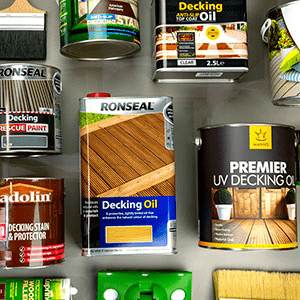Driveway and Garden Gate FAQ's
Do I need to use a wood preservative on newly made driveway gates?
What is the best preserver for a plywood gate?
This really depends on what you're going to be finishing it with. If you're going to be using a wood paint or a wood oil, you're better off using Barrettine Premier Universal Preserver or Sadolin Quick Drying Wood Preserver which are compatible with most types of top coats.
If you want an all-in-one product which colours, seals and protects, then products such as Barrettine Premier Wood Preserver, Ronseal Total Wood Preservative or Cuprinol Ultimate Garden Wood Preserver will do all of the above. Alternatively, see our wood preservative treatments page for more information.
We are about to fit new drive gates and the manufacturer recommends Osmo UV-Protection - Extra. How often would this need to re-treating? I did not see this in the data sheets. The location is under trees so will be more subject to algae and fungal problems rather than UV damage.
Are you able to confirm what type of wood the gates are made from please? This will help with the advice we can provide.
Knowing how long the oil finish will last is dependent on how much wind, rain and sun the gates are exposed to. Because of this, Osmo are unable to give a specific time frame of how long the oil finish will last but as a very rough guide from other users experiences, the finish will probably be good for 2 plus years, before requiring a maintenance coat. This is just an estimation and is very dependent on the amount of weathering they receive.
Before oiling the gates we recommend that they are treated with a mould and mildew cleaner. This includes all edges, top and bottom, and especially any 'cut ends' or 'end grain'. Although there may not be any visible signs of mould or algae when the gates are delivered or installed, If the wood has at anytime been damp or wet, mould spores could already be present in the surface grain of the timber. Using a mould and mildew cleaner will kill off any spores in the wood prior to oiling.
The next phase would be to treat the wood with a wood preservative. Using a wood preserver will help to protect the wood from mould, algae and insect attack. Osmo WR Base Coat (4001) is a good choice and compatible with Osmo UV Protection Oil Extra.
It's worth checking the gates on a semi-regular basis for signs of mould, algae and water penetration. The first places to be affected are usually the flat, horizontal surfaces where water can collect and sit. This can degrade the finish and promote organic growth over-time. If there is any sign that these surfaces have lost there ability to repel water, simply apply a thin maintenance coat of oil when the wood is dry. In the event of mould or algae appearing, re-treat with the mould and mildew cleaner then re-oil the affected area once dry
In general, hardwood gates made from exotic hardwoods such as teak and Iroko are naturally more resistant to weathering, biological threats and rot. Gates made from Oak or softwoods need more care and maintenance but if well maintained, can last for many decades.
I want to protect a set of solid Iroko gates and am confused about the amount of options. I have been recommended Sikkens but even here there are loads of options. The gates have previously been treated with (not sure of brand or product here) a tin of treatment from B+Q and the finish is sort of a hard varnish with a slight tint. If I sand this then the colour goes immediately lighter. So my question, If I wanted a matt finish without a lot of colour (but some to cover the age of the gates) what should I go for. As a follow up question, how should I prepare the gates - sanding etc. and can I or should I use a roller to apply.
Unless treated with a wood oil, it's always better to remove any previous wood treatments and take the item back to clean, bare wood.
Wood oils are a good option for exterior wood as they penetrate into the wood grain and protect the wood from moisture and weathering. Oils are very easy to apply and maintain and will never crack, flake or peel over time. For Iroko, which is an oily tropical Hard wood, not all exterior wood oils would be suitable. Our recommendation for Iroko gates would be Osmo Decking Oil. This is because it is a thinner oil than others and more suited to exotic hardwoods. Although it is clear, it will darken the wood to some degree in the same way that water would. To get an indication of how the gates will look if oiled, once sanded back, wipe over a section with a clean sponge and water to dampen the wood. How this looks when damp is a good indication of how it will look ones oiled.
Alternatively, Sikkens Cetol HLS Plus followed by Sikkens Cetol Filter 7 Plus could be an option. These are coloured, varnish type finishes that coat the surface of the wood. The pigments in these products act as UV filters to provide the wood additional protection from the greying effects of UV damage.
Both of these options will weather and require maintenance from time to time. It's always difficult to give a maintenance time frame as it really is dependent on how much wind, rain and sun the gates get. Saying this, it's normally easy to tell as the finish will start to loose some of its lustre and will start to look tired and perhaps a little dull.
As Iroko is a naturally oily wood, it should be wiped down with Methylated Spirits, after sanding and before applying either of the above products. This is to remove any surface oil or grease that could cause adhesion problems and especially so with Sikkens products.Before starting any project we always recommend doing a test area to assess product suitability and final finish.
Related gate finishing blog posts
- Garden Gates – The Essential Guide
Disclaimer: Whilst every attempt has been made to provide product information that is as accurate as possible, it's important to clarify that trees and the wood that they produce can be affected by many factors. For example, the same species of tree grown in the same wood, even in close proximity, will be affected by age along with the amount of sunlight and water they receive. Other naturally occurring biological and environmental factors will also influence the density and grain of the wood as well as the moisture and oil content of the timber. No two trees are the same, meaning each piece of wood has the potential to look and react differently to the same wood finish. For example, product adhesion, colour variations, absorption rates and sheen levels. It is for this reason that we always strongly recommend carrying out test areas before starting any project


